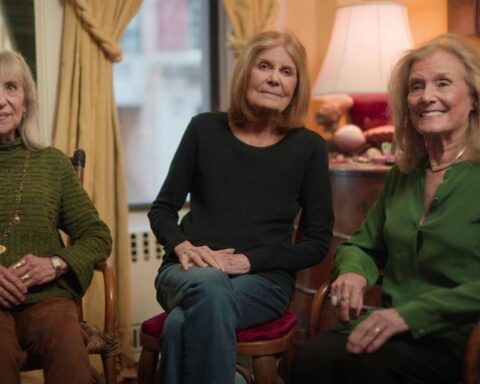Seeing Allred
(USA, 96 min.)
Dir. Sophie Sartain, Roberta Grossman
“I don’t think Gloria is in a popularity contest because if she is, she lost that one,” says lawyer and commentator Greta Van Susteren in the new Netflix documentary Seeing Allred. Van Susteren laughs about the no-nonsense attitude of civil rights lawyer Gloria Allred as this documentary by Sophie Sartain and Roberta Grossman offers a highlight reel of Allred’s image on television throughout the decades. The montage includes a South Park spoof and an impersonation on The Simpsons that introduces her as a “shrill feminist lawyer.” Seeing Allred unabashedly unabashedly plays up the image of Allred as the passionate and assertive feminist and doesn’t tear it down as she dismantles the patriarchy brick by brick. It’s the spirit the reinvigorated movement needs.
Imagine seeing the explosion of the Women’s March and the #MeToo movement while standing alongside a feminist figure like Gloria Allred. Now imagine witnessing history in the making while filming a doc profile of this civil rights lawyer. Timing can be a wonderful thing and Sartain and Grossman benefit, capturing contemporary history through the perspective of a woman who has led the charge for gender equality in the USA. One just wishes they’d marinated in her story a little longer. This (too) timely documentary lets the polarizing figure open up and provide insight to the fire behind her fury. Her story resonates with an ongoing battle that’s been fought for too long.
Interviews with Allred let the subject explain her story and it’s an all-too familiar tale of a smart and talented woman who became a mother quickly while at university and only completed her education after moving back with her parents. As Allred explains her journey through tragic marriages and her growth while working as a single mother, student, teacher, and eventually lawyer, the doc highlights the fires of social justice and activism fuelling her along the way. Allred’s passionate civil rights advocacy prompts her to apply the same action towards women’s rights and the rest is history.
Sartain and Grossman find a great wealth of archival footage to show Allred’s fight on talk shows and prime time TV. Images from classic talk shows offer clips of her encountering the old-school boys’ club who dismissed her concerns and used the word “feminist” as a pejorative to the delight of the chortling audience. Cut to 2016 and the footage of Donald Trump is essentially the same, but in high definition. Allred’s fight for women’s rights collides with the arrogant pig and his run for the presidency. Everything in the lawyer’s career anticipates the contemporary state of things where the White House is the institution of misogyny. Despite all the vulgar chauvinism on the classic TV shows, nobody in the archival footage has the tactlessness to brag about grabbing women “by the pussy” and winning the admiration of the silent majority by doing so.
The doc devotes significant time to Allred’s effort to ferret out sexual predators. She uses her strategic press conferences and media presence to challenge the establishment with Bill Cosby as her key Jenga block to topple the perceived invincibility of powerful men. Seeing Allred shows the lawyer lead woman upon woman before the press to share experiences of surviving sexual assault, harassment, and misconduct by Cosby’s hands. The film advocates for the rights of survivors and offers a valuable tool for the language and sensitivity with which one should approach stories of sexual violence. Allred even shares her own story about surviving a rape and experiencing a dangerous back alley abortion as part of the larger circle of violence that contextualizes her activism.
The Trump and Cosby narratives let Seeing Allred tap into the recent surge of support for women’s rights that emerged as a response to Trump’s inauguration at the same time the #MeToo movement inspired the wave of sexual assault allegations from Hollywood. The doc features some great footage of Allred on the front lines of the movement, going toe to toe with toxic Trump supporters, and the images could easily rattle a viewer. The doc also shows Allred as a frequent commentator on the Harvey Weinstein allegations, but the footage of her in action against Hollywood’s rape machine mostly sticks to Cosby. This aspect of the doc is especially glaring since Allred’s daughter, Lisa Bloom, who appears in the film, briefly served as Weinstein’s lawyer following the first reports against the fallen producer. There is a much-needed element of drama here that feels lacking. Seeing Allred doesn’t pursue an opportunity to do more than merely insert one narrative into another.
The immediacy of the Trump election and the #MeToo movement provide the hooks to attract viewers to Seeing Allred, but they might be the doc’s downfall as well since the act of capturing history in the making ultimately leaves the film feeling rushed and unfinished. Seeing Allred is a perfectly safe and neatly packaged profile documentary that adds little to the cause beyond a humanizing portrait of its galvanizing subject. This Sundance-to-Netflix quickie should satisfy fans who love a heaping dose of zeitgeist in their documentaries, but there are at least two films at play here and one suspects that a better, fuller portrait of Allred could do more service to the unabashed social justice warrior and the contemporary cultural reckoning of which she is invaluably a part.
Seeing Allred debuts on Netflix Feb. 9.
p=.

Courtesy Netflix











